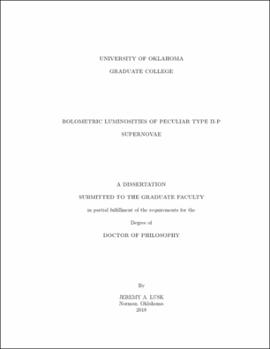| dc.description.abstract | In this work, I analyze the bolometric luminosities of several peculiar Type II-P supernovae which are thought to originate from the same class of blue supergiant progenitor stars as the famous SN 1987A. This analysis is performed with the new open-source code SuperBoL (Supernova Bolometric Lightcurves.) I wrote SuperBoL to implement several different bolometric luminosity calculation techniques commonly used in the literature. I then use SuperBoL to estimate the bolometric luminosities of the five peculiar Type II-P supernovae in this study: SN 1998A, SN 2000cb, SN 2006V, SN 2006au, and SN 2009E, using photometry, extinction, and distance values from the literature. The results show that the quasi-bolometric technique typically produces bolometric luminosities about half as bright as the other techniques, dependent in large part on the wavelength range of the available photometric bands. The augmented bolometric technique produces luminosities which are systematically higher than those from the bolometric correction technique for all but SN 2000cb, where they largely agree. One parameter of the supernova which can be measured directly from the bolometric lightcurve is the mass of ejected Ni-56, the radioactive decay of which powers the lightcurve after the plateau-phase. These masses vary by a factor of about 3, depending on which lightcurve is used to obtain them. In order to understand why the different bolometric luminosity calculation techniques produce such different values, I use the advanced general-purpose radiative transfer code PHOENIX to produce a grid of 26 synthetic supernova spectra of different known luminosities, constructed to closely match observed spectra of both SN 2000cb and SN 2006au. Taking the synthetic photometry of these PHOENIX models and running them through SuperBoL produces 156 different comparisons between known and calculated bolometric luminosities. These results show that in most cases, the quasi-bolometric technique under-estimates the bolometric luminosity of the models by about 50%. With IR photometry in the J and H bands, this can be improved to an under-estimation of only 10% - 15%. The augmented bolometric method performs much better, in some circumstances re-producing the bolometric luminosity of the model within 1%. I find that the accuracy of the augmented bolometric technique depends sensitively on the wavelength range of the available photometry and the photometric bands used when fitting a blackbody curve to the spectral energy distribution derived from the photometry. The best results are obtained when the fit is restricted to fluxes at wavelengths longer than the peak of the SED, only. The bolometric correction method implemented in SuperBoL performs quite well across the range of PHOENIX models, producing bolometric luminosities which typically fall within 3% - 7% of the model luminosity. However, because the bolometric correction technique depends only on the photometric colors of the supernovae, it will produce erroneous results if those colors stray outside the range typical of the template supernovae used to construct the polynomial relations between the colors and bolometric corrections. | en_US |
